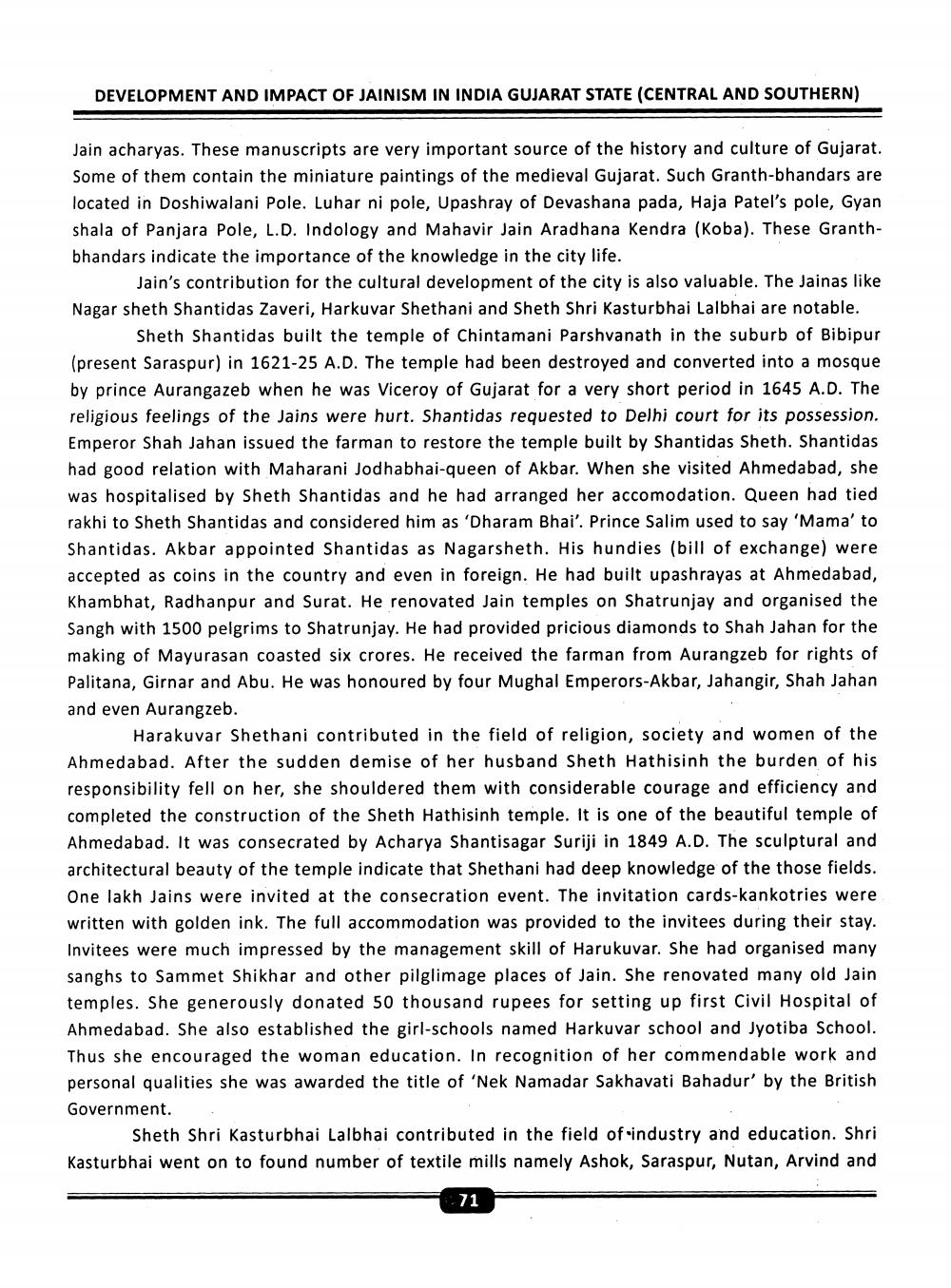________________
DEVELOPMENT AND IMPACT OF JAINISM IN INDIA GUJARAT STATE (CENTRAL AND SOUTHERN)
Jain acharyas. These manuscripts are very important source of the history and culture of Gujarat. Some of them contain the miniature paintings of the medieval Gujarat. Such Granth-bhandars are located in Doshiwalani Pole. Luhar ni pole, Upashray of Devashana pada, Haja Patel's pole, Gyan shala of Panjara Pole, L.D. Indology and Mahavir Jain Aradhana Kendra (Koba). These Granthbhandars indicate the importance of the knowledge in the city life.
Jain's contribution for the cultural development of the city is also valuable. The Jainas like Nagar sheth Shantidas Zaveri, Harkuvar Shethani and Sheth Shri Kasturbhai Lalbhai are notable.
Sheth Shantidas built the temple of Chintamani Parshvanath in the suburb of Bibipur (present Saraspur) in 1621-25 A.D. The temple had been destroyed and converted into a mosque by prince Aurangazeb when he was Viceroy of Gujarat for a very short period in 1645 A.D. The religious feelings of the Jains were hurt. Shantidas requested to Delhi court for its possession. Emperor Shah Jahan issued the farman to restore the temple built by Shantidas Sheth. Shantidas had good relation with Maharani Jodhabhai-queen of Akbar. When she visited Ahmedabad, she was hospitalised by Sheth Shantidas and he had arranged her accomodation. Queen had tied rakhi to Sheth Shantidas and considered him as 'Dharam Bhai'. Prince Salim used to say 'Mama' to Shantidas. Akbar appointed Shantidas as Nagarsheth. His hundies (bill of exchange) were accepted as coins in the country and even in foreign. He had built upashrayas at Ahmedabad, Khambhat, Radhanpur and Surat. He renovated Jain temples on Shatrunjay and organised the Sangh with 1500 pelgrims to Shatrunjay. He had provided pricious diamonds to Shah Jahan for the making of Mayurasan coasted six crores. He received the farman from Aurangzeb for rights of Palitana, Girnar and Abu. He was honoured by four Mughal Emperors-Akbar, Jahangir, Shah Jahan and even Aurangzeb.
Harakuvar Shethani contributed in the field of religion, society and women of the Ahmedabad. After the sudden demise of her husband Sheth Hathisinh the burden of his responsibility fell on her, she shouldered them with considerable courage and efficiency and completed the construction of the Sheth Hathisinh temple. It is one of the beautiful temple of Ahmedabad. It was consecrated by Acharya Shantisagar Suriji in 1849 A.D. The sculptural and architectural beauty of the temple indicate that Shethani had deep knowledge of the those fields. One lakh Jains were invited at the consecration event. The invitation cards-kankotries were written with golden ink. The full accommodation was provided to the invitees during their stay. Invitees were much impressed by the management skill of Harukuvar. She had organised many sanghs to Sammet Shikhar and other pilglimage places of Jain. She renovated many old Jain temples. She generously donated 50 thousand rupees for setting up first Civil Hospital of Ahmedabad. She also established the girl-schools named Harkuvar school and Jyotiba School. Thus she encouraged the woman education. In recognition of her commendable work and personal qualities she was awarded the title of 'Nek Namadar Sakhavati Bahadur' by the British Government.
Sheth Shri Kasturbhai Lalbhai contributed in the field of industry and education. Shri Kasturbhai went on to found number of textile mills namely Ashok, Saraspur, Nutan, Arvind and
-71




